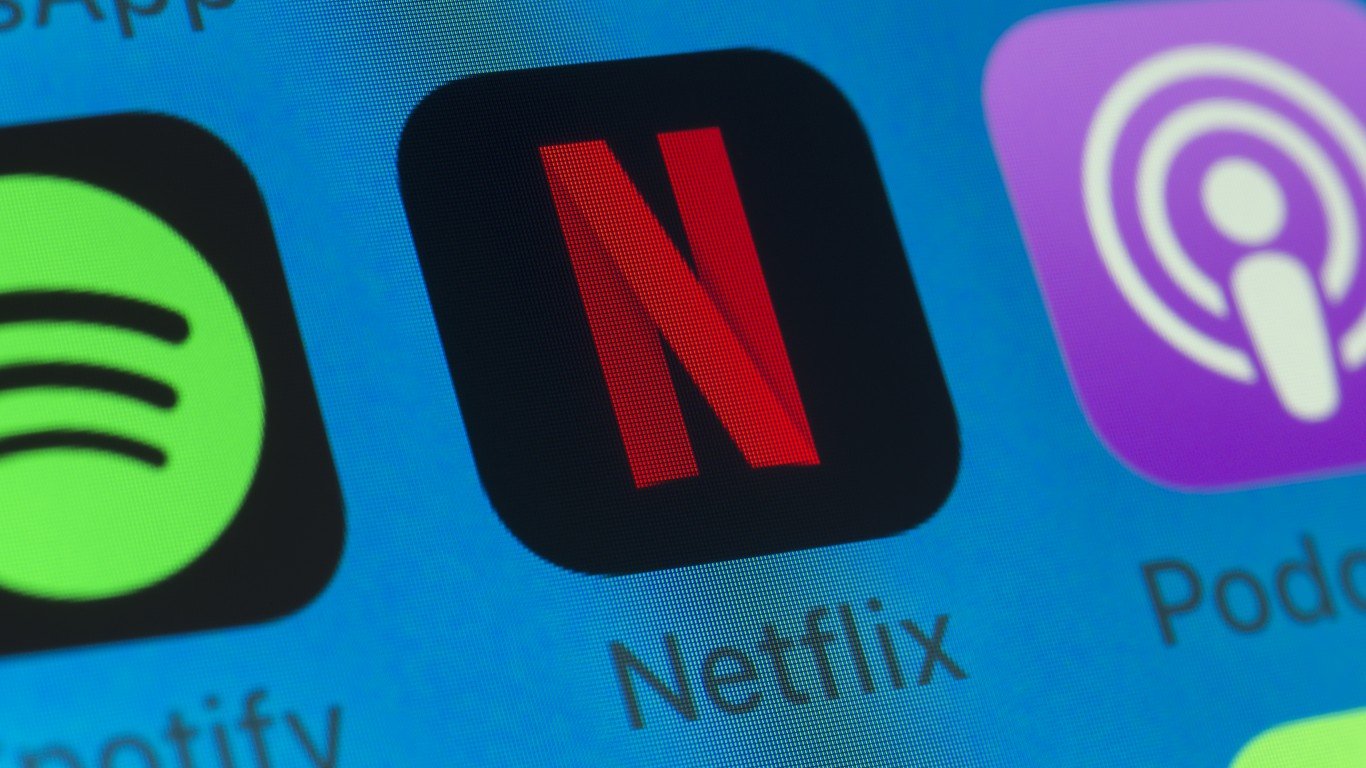

Two companies we previewed reported earnings Monday morning, and both beat consensus estimates on both the top and bottom lines. But that’s pretty ho-hum these days. Less than 10% of S&P 500 companies have already reported September earnings, but about 80% of those have posted a positive earnings surprise. That’s above the five-year average of 76%.
About 325 companies are scheduled to report quarterly results this week, including several airlines, a couple of FAANG stocks, some big defense contractors and even a couple of meme stocks. We already have previewed five firms reporting results after markets close Monday or before Tuesday’s opening bell: Halliburton, Johnson & Johnson, Philip Morris, Procter & Gamble and Steel Dynamics.
[in-text-ad]
Here are five more reporting after Tuesday’s closing bell or before markets open on Wednesday.
Baker Hughes
Over the past 12 months, oilfield services firm Baker Hughes Co. (NYSE: BKR) has seen its share price more than double. However, that increase included two troughs that saw the stock drop by almost 50%. Since mid-July, however, the stock is up nearly 40% on the oil and gas price hikes and the expectation that more drilling is coming soon in the energy patch. Baker Hughes reports quarterly results before markets open Wednesday.
The company’s weekly report last Friday on the number of working drilling rigs was up for the sixth straight week to 543, including 445 rigs drilling for oil and 98 drilling for natural gas. That’s still below the rig count in April of this year.
Analysts are solidly bullish on the stock, with 23 of 29 putting a Buy or Strong Buy rating on the shares. The rest rated the stock at Hold. At a recent price of around $26.80, the upside potential based on a median price target of $29 is 8.2%. At the high price target of $38, the implied upside is nearly 33%.
The consensus third-quarter revenue estimate is $5.33 billion, which would be up 3.6% sequentially and 5.5% higher year over year. Adjusted earnings per share (EPS) are forecast to rise sequentially by 113.5% to $0.21. That’s a year-over-year increase of 425%. For full fiscal 2021, analysts are forecasting EPS to rise 2,500% to $0.78 on sales of $21 billion, or up 1.4%.
Baker Hughes stock trades at 34.6 times expected 2021 EPS, 21.3 times estimated 2022 earnings and 15.9 times estimated 2023 earnings. The stock’s 52-week range is $13.08 to $27.66, and the high was posted Friday. Baker Hughes pays an annual dividend of $0.72 (yield of 2.68%).
Netflix
Earlier this month, Netflix Inc. (NASDAQ: NFLX) posted a new 52-week high on the strength of a South Korean production of a dystopian future called “Squid Game.” Citing company data it was able to review, Bloomberg said the show will create almost $900 million in value for Netflix. Even better news for the company is that its third season of the thriller “You” has dethroned “Squid Game” to take over the top spot on the U.S. streaming charts. “Squid Game” began its run in mid-September, so it will have some impact on third-quarter results when Netflix reports after markets close Tuesday.
[in-text-ad]
While analysts are unanimous in their evaluations of Netflix, 33 of 44 rate the stock a Buy or Strong Buy and another six rate the shares a Hold. At a price of around $632.00, the upside potential based on a median price target of $650 is 2.8%. At the high price target of $780, the upside potential is 23.4%.
Third-quarter revenue is forecast at $7.48 billion, up 1.9% sequentially and 16% year over year. Adjusted EPS are forecast at $2.56, down nearly 14% sequentially but up 47% year over year. For the full fiscal year, analysts currently expect to see EPS of $1.13, up nearly 74%, on sales of $29.66 billion, nearly 19% higher.
Netflix shares trade at 59.7 times expected 2021 EPS, 48.3 times estimated 2022 earnings and 36.9 times estimated 2023 earnings. The stock’s 52-week range is $463.41 to $646.84. Netflix does not pay a dividend, but the share price jumped about 19% over the past 12 months, including a 23% increase since mid-August.
NextEra Energy
Shares of regulated electricity company NextEra Energy Inc. (NYSE: NEE) have risen by about 9% over the past 12 months. The Florida-based utility is already the world’s largest producer of electricity using solar and wind energy, and recently it reported a backlog of some 16,700 megawatts of signed contracts. Given the recent attention to ESG stocks and funds as perhaps more than a little greenwash, NextEra stands out even more. The company reports third-quarter results before the opening bell on Wednesday.
None of the 22 ratings on NextEra stock is lower than Hold. Of the total, 16 brokerages rate the stock a Buy or Strong Buy. At a price of around $81.10, the upside potential based on a median price target of $90.50 is about 11.6%. At the high price target of $102.80, the implied gain is nearly 27%.
Third-quarter revenue is forecast to come in at $5.35 billion, up 36.3% sequentially and 11.7% year over year. Adjusted EPS are forecast to be flat sequentially at $0.71 and up about 6% year over year. For the full fiscal year, current estimates call for EPS of $2.52, up 9.3%, on sales of $19.3 billion, up 7.25%.
NextEra shares trade at 32.2 times expected 2021 EPS, 29.6 times estimated 2022 earnings and 27.6 times estimated 2023 earnings. The stock’s 52-week range is $68.33 to $87.69, and NextEra pays an annual dividend of $1.54 (yield of 1.89%).
United Airlines
When competitor Delta reported third-quarter results last week, it beat consensus estimates on both the top and bottom lines, yet the stock closed lower and has been drifting downward ever since. United Airlines Holdings Inc. (NASDAQ: UAL) managed to hold its stock price relatively flat since Delta’s announcement, but that may be due to low expectations for the carrier. United has recently suspended some flights from San Francisco and announced an expansion to its transatlantic flights beginning next year.
[in-text-ad]
Airlines (and other travel industry businesses) are betting (again) that the coronavirus pandemic will be in the rear-view mirror for good by next summer’s travel season. United’s outlook may be more important than its numbers when it reports results after markets close Tuesday. Over the past 12 months, United’s stock has added roughly 40% to its share price.
Analysts are primarily in a wait-and-see mode with the stock. Of 22 brokerages covering the firm, 10 have assigned the stock a Hold rating, and eight rate the stock a Buy or Strong Bug. There are also three Strong Sell ratings on the company. At a price of around $47.70, the upside potential based on a median price target of $58 is nearly 24%. At the high price target of $78, the upside potential rises to 63.5%.
The consensus third-quarter revenue forecast calls for sales of $7.64 billion, up nearly 40% sequentially and about 207% higher year over year. Analysts are forecasting an adjusted loss of $1.68 per share, better than the $3.91 loss per share posted in the second quarter and much better than the $8.16 per share loss in the year-ago quarter. For the full fiscal year, analysts expect a loss per share of $13.33, less than half the $27.57 per share loss posted a year ago. Revenue is forecast to rise by 61% to $24.7 billion.
The stock trades at 16.4 times estimated 2022 earnings and 6.1 times estimated 2023 earnings. The stock’s 52-week range is $32.16 to $63.70, and United does not pay a dividend.
Verizon
Telecom giant and Dow Jones industrial Verizon Communications Inc. (NYSE: VZ) reports third-quarter results early Wednesday. Over the past 12 months, the share price has dropped by nearly 6%, as well as by 7% for the year to date.
Verizon has spent big on 5G spectrum licenses this year but reportedly pulled out of an October 8 auction, causing the auction to miss its reserve minimum of $14.8 billion. Verizon has spent more than $45 billion on spectrum this year, more than 2.5-times is capital spending in all of last year. In seven of the eight immediately past quarters, Verizon has beaten EPS estimates, and in six it also has beaten revenue estimates.
While analysts are definitely cool toward Verizon’s potential to grow its share price, the company’s massive dividend yield makes it hard to recommend selling the stock. Of 27 analysts, seven rate the stock as a Buy or Strong Buy, and 19 rate the shares a Hold. At a price of around $52, the implied gain based on a median price target of $60 is 15.4%. At the high price target of $68, the potential upside is almost 31%.
Third-quarter revenue is forecast to come in at $33.26 billion, down about 1.5% sequentially and up 5.5% year over year. Adjusted EPS are forecast at $1.36, down a penny sequentially and up 8.8% (11 cents) year over year. For the full 2021 fiscal year, analysts currently expect Verizon to post EPS of $5.72, up 7.7%, on sales of $134 billion, up 4.5%.
Verizon stock trades at 9.9 times expected 2021 EPS, 9.8 times estimated 2022 earnings and 9.6 times estimated 2023 earnings. The stock’s 52-week range is $50.86 to $61.95. Verizon pays an annual dividend of $2.56 (yield of 4.9%).
Take This Retirement Quiz To Get Matched With A Financial Advisor (Sponsored)
Take the quiz below to get matched with a financial advisor today.
Each advisor has been vetted by SmartAsset and is held to a fiduciary standard to act in your best interests.
Here’s how it works:
1. Answer SmartAsset advisor match quiz
2. Review your pre-screened matches at your leisure. Check out the
advisors’ profiles.
3. Speak with advisors at no cost to you. Have an introductory call on the phone or introduction in person and choose whom to work with in the future
Take the retirement quiz right here.
Thank you for reading! Have some feedback for us?
Contact the 24/7 Wall St. editorial team.
 24/7 Wall St.
24/7 Wall St.


